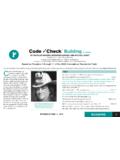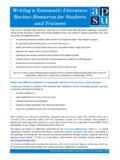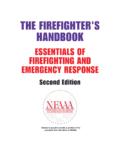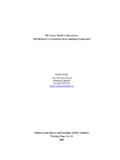Transcription of INTRODUCTION CODES ABBREVIATIONS Code …
1 INTRODUCTION u CODES u ABBREVIATIONS sequence of this bookThis book follows the same basic sequence as the IRC. It begins with the administrative sections in the IRC chapter 1, followed by the planning and nonstructural topics in the IRC chapter 3. The structural sections are arranged from the ground up, beginning with foundations (chapter 4), followed by floors (5), wall construction (6), wall coverings (7), roof-ceiling construction (8), roof assemblies (9), and chimneys and fireplaces (10). ABBREVIATIONS In 1735, Benjamin Franklin organized the first volunteer fire department in Philadelphia, which still remains the model for fire 3 Check Building Third Editionby DouGLAs hAnsen & reDwooD kArDonIllustrations & Layout: Paddy Morrissey 2011 by The Taunton Press, Inc.
2 ISBN-13: 978-1-60085-329-6 code Check is a registered trademark of The Taunton Press, Inc., registered in the Patent & Trademark Office. Printed in updates and information related to this book, visit check building is a condensed guide to the building portions of the 2009 International Residential code (IRC) for One- & Two-Family Dwellings. The IRC is the most widely used residential building code in the United States. Significant code changes are highlighted in the text and summarized in the inside back cover, which means that the book is also applicable in areas using older editions of the IRC. Check with the local building department to determine which code is used in your area, and for local DocuMentsThe IRC is part of the suite of CODES published by the International code Council.
3 It is limited to one- and two-family dwellings and townhouses not more than 3 stories above grade. It is a prescriptive document containing rules and instructions. Aspects of a building that exceed the scope of the IRC are built to the IBC, a more compre-hensive document containing engineering regulations for structural design. It is ac-ceptable to use any of the specific performance-based provisions of the International CODES as an alternative to the prescriptive rules in the American Forest and Paper Association publishes the Wood Frame Con-struction Manual for One- and Two-Family Dwellings (WFCM), which can be used as an alternate to IRC designs for wood framing. The American Iron and Steel Institute (AISI) publishes the Standard for Cold-Formed Steel Framing Prescriptive Method for One- and Two-Family Dwellings (AISI S230), which can be used as an alternative to the American Concrete Institute (ACI) publishes two documents that supple-ment the prescriptive rules of the IRC.
4 These are ACI 318 Building CODES for Struc-tural Concrete and ACI 530 Building code Requirements for Masonry Truss Plate Institute (TPI) publishes TPI 1 National Design Standard for Metal Plate Connected Wood Truss Construction, which is mandatory for metal-plate-connected truss design. TPI also contributes to BCSI 1-03 Guide to Good Practice for Handling, Installing & Bracing of Metal Plate Connected Wood to usinG this bookThe line for each code rule starts with a checkbox and ends with an IRC code reference in brackets. Exceptions and lists start with a bullet and also end with the code reference in brackets. Changes to the 2009 code are highlighted by having the reference in a different color and an endnote to the table on the inside back cover.
5 Example from :n Floor or landing min 36in deep on each side of door EXC _____[ ] Balconies <60sq. ft OK for landing to be <36in deep _____[ ]19 These lines give the basic rule that landings at least 36 inches deep are required on each side of a door, and the code reference in the IRC is section (In the IRC, the number is actually We omit the letter R at the beginning to save space and include more information on each line.) The line that follows is an exception to the rule, and the code reference is Exception. This exception is a new code change, and is explained further on the inside back cover as code change # and Figures are referenced in the code text lines in the following way:Example from.
6 N Notching & boring per f30 & t14 _____[ ]This line says that the rules for notching & boring joists are found in section and illus-trated in figure 30, with further explanation in table = American Architectural Manufacturers AssociationAci = American Concrete InstituteAMi = in accordance with manufacturer s instructionsAstM = American Society for Testing & Materialsbo = building officialbwL = braced wall linebwP = braced wall panelcfm = cubic feet per minutecMu = concrete masonry uniteXc = exception to rule will follow in the next linefsD = fire separation distanceft = feetGb = gypsum boardhr = houribc = International Building Codeicf = insulating concrete formin = inchesL&L = listed and labeledmax = maximummin = minimummph = miles per = on
7 CenterPL = property linePt = pressure treatedpsf = pounds per square footpsi = pounds per square inchreq = requirereq d = requiredreq s = requires, requirementssDc = Seismic Design Categorysq. = square, as in sq. ftw/ = withw/o = withoutwrb = water-resistive barrierwsP = wood structural panel Based on Chapters 1 through 10 of the 2009 International Residential code PLANNING u PERMITS u INSPECTIONS u DESIGN 2 PLANNING, PERMITS & INSPECTIONS before beginning a building or project, plans must be approved by the local building department and must conform to applicable climatic and geographic design criteria. The plans must include setbacks from the property lines and adjacent & Permits 09 ircn Scope of code is 1- & 2-Family Dwellings & Townhouses _____[ ]n Approved plans & permit card on site _____[ ]n Plans to include braced wall line locations & methods _____[ ]4n Alternative materials, design & methods OK when approved by BO _[ ]n Local statutes may req registered design professional to draw plans _[ ]n Site plan or plot plan to be included in construction documents _____[ ]n Permits req d for new work, additions, repairs & alterations _____[ ]n Permits not req d for: _____[ ] Detached accessory structures (tool sheds) 200 sq.
8 Ft5 Fences 6ft, sidewalks, driveways, swings & playground equipment Retaining walls 4ft bottom of footing to top of wall & w/ no surcharge Water tanks on grade 5,000 gallons & height/width ratio 2:1 Painting, tiling, carpeting, cabinets, counters & similar finish work Awnings projecting 54in from exterior wall & supported from wall Decks 200 sq. ft & 30in above grade & not attached to dwelling or serving req d exit door6required inspections 09 ircn Inspection & approval prior to concealing any work _____[ ]n Foundation forms & steel prior to placing concrete _____[ ]n In flood hazard areas, registered design professional req d to document lowest floor elevation before construction above it _____[ ]n Rough plumbing, mechanical & electrical before concealment _____[ ]n Frame & masonry after fireblocking & bracing in place _____[ ]n Air barrier & insulation inspection (may be 3rd party)
9 _____[ ]n Drywall nailing of fire-resistance rated walls prior to taping _____[ ]n Special inspections as authorized by BO _____[ ]n Final inspection_____[ ]tAbLe 1 cLiMAtic AnD GeoGrAPhic conDitions [ (1)]Ground Snow LoadWind Speed (mph)ASeismic Design CategoryAWeathering(Concrete)bFrost Line DepthATermitesHazardAFlood HazardscA. To be filled in by local building Choose negligible, moderate, or severe affects strength of concrete & grade of To reference entry date into National Flood Insurance Program, date of Flood Insurance Study & numbers & dates of currently effective the IRC assigns a Seismic Design Category (SDC) from A to E, with A the least likely to experi-ence seismic activity and E the most vulnerable.
10 Category D is broken into three subparts, D0, D1 & D2. Buildings in SDC E must be designed to the IBC. The BO can allow an E to be designated as D2 in some circumstances, such as buildings of regular shape with wall bracing continuous in one plane from the foundation to the uppermost story and no cantilevers. Design criteria General irc 09n Nonconventional elements designed per IBC _____[ ]n Determine climatic & geographic design criteria t1 _____[ ]n Complete t1 from maps & BO _____[ (1-6)]n In flood hazard areas, determine design flood elevation _____[ ]n BO may req soil tests if expansive, compressible, or questionable ___[ ]wind Design irc 09n Determine basic wind speed from maps _____[ (4)]









